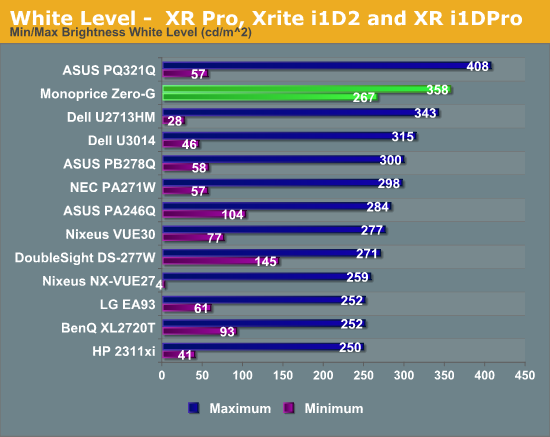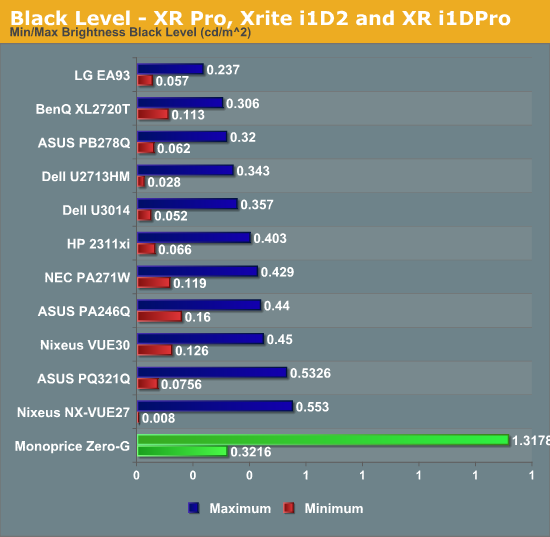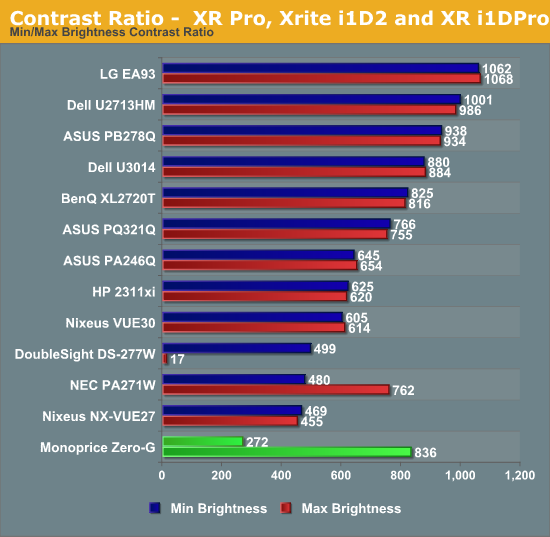Monoprice Zero-G Slim 27" IPS Monitor Review
by Chris Heinonen on August 26, 2013 12:00 AM ESTThe Zero-G is rated for 440 cd/m^2 of brightness, but with the default contrast setting I couldn’t get close to that. I only managed to produce 348 cd/m^2 of brightness with the Brightness at max and Contrast at 50. Pushing the Contrast higher might push that value higher, but it also introduces clipping that makes those settings unusable.
The curious value with the Monoprice is the minimum white level. At the default Contrast setting of 50 and the Brightness at 0, we still see 267 cd/m^2 of light output. That’s over 30% higher than our bright target for calibration and pre-calibration readings! I like to see the minimum level be closer to 80 cd/m^2 or below, so this is a small range. As you see on the chart, the Monoprice really sticks out here.

Black level also has issues. With the Brightness at 100 and Contrast at 50, we see a black level of 1.3178 cd/m^2. We really look for a value of 0.300 cd/m^2 or below to be excellent, and past 0.500 cd/m^2 is not great. Beyond 1.0 shows that we have grayish blacks, not black-blacks, and the contrast ratio is going to really suffer.
At the Brightness level of 0, our black level is a more respectable 0.3216 cd/m^2. The minimum brightness levels are what I’d expect to see at maximum brightness on a typical display. As almost everyone is using LG panels in their 27” 1440p monitors, there is something in the electronics of the Monoprice that is certainly strange.

The contrast levels, as you can imagine from that maximum brightness reading, are strange. We see a respectable contrast level of 836:1 at minimum brightness, but a maximum brightness contrast of only 272:1. When these values don’t line up with each other, or with the 200 cd/m^2 calibrated values, I go back and run this at multiple levels to see what is going on. Below is the data for the light output and contrast ratio at different brightness levels.
|
Brightness Level |
Light Output (cd/m^2) |
Contrast Ratio |
|
0 |
267 |
836:1 |
|
10 |
290 |
888:1 |
|
20 |
312 |
944:1 |
|
30 |
330 |
992:1 |
|
40 |
352 |
1054:1 |
|
50 |
354 |
1054:1 |
|
60 |
354 |
1055:1 |
|
70 |
354 |
1054:1 |
|
80 |
355 |
830:1 |
|
90 |
356 |
520:1 |
|
100 |
358 |
272:1 |
As we see the light output doesn’t really change from 40-70, and past 70 the black level rises causing the contrast ratio to fall. Contrast Ratio should be constant, with small fluctuations due to reading error. Because of the behavior seen here, I chose to do all my calibrations at the default settings of Brightness 50 and Contrast 50. However, there is something going on with the electronics inside the Monoprice display, and it doesn’t look right.
Monoprice looked into this and informed me that the backlight level is controlled by the scaler and not by the pcb mainboard. This is causing the brightness controls to not function as I expect them to, and it sounds like it won't be changed.











79 Comments
View All Comments
blackoctagon - Tuesday, August 27, 2013 - link
Minor pedantic correction: lack of OSD and a scaler (plus the fact that there is only DVI as the sole supported input) keeps input lag and overall latency low, but the pixel response time of the S-IPS panel remains the same as before, i.e., "approximately 6ms or less (GTG)"Koblek - Tuesday, August 27, 2013 - link
Thanks for the correction blackoctagon:)blackoctagon - Tuesday, August 27, 2013 - link
In a recent BenQ review Chris claimed that he would review these if he could get his hands on a sample. At the time he seemed unaware of Overlord - he claimed that the only overclockable IPS screens were imports - so I hope he will eventually review these delightful monitors.That said, no I'm not aware of any 'official'/pro reviews, just lots of glowing user reports
Subyman - Monday, August 26, 2013 - link
I have a korean 27" and it is a solid monitor. I also have a Viewsonic VP2770LED and it blows the korean monitor away in terms of quality and image. The step up from a typical TN to the korean is enormous, but so is the jump from the Korean to a fully featured high end monitor. Something that is very important for some people is the PWM dimming. I had major issues with head aches using the Korean monitor daily, while the Viewsonic has been pain free.atx9307 - Monday, August 26, 2013 - link
If anyone is looking to make a purchase at Monoprice now through 9/15, use code EMP1166 to get the lowest pricing listed on the site :)borderdeal - Monday, August 26, 2013 - link
I bought a X-Star monitor from ebay. I also got a Eye-one Display 2 calibrator for $35 shipped from ebay. I upgraded from a 27" 1920*1200 TN monitor. The X-star is way way better in color and viewing angels as expected. But calibrating the monitors made a big difference in both monitors. Even in the TN panel that I was amazed and regret not buying the Eye-one Display 2 before.cheinonen - Tuesday, August 27, 2013 - link
FYI (and for everyone else), the i1Display2 hasn't been made for a few years now. It has a non-sealed optics design that is especially prone to drift. I compared mine (kept in a sealed bag with silica) to a NIST-certified i1Pro the other year and the i1Display2 had an average dE2000 error of close to 10.0. They can measure light output fine, but getting color accuracy from them after more than a year or two just doesn't happen due to the design.Impulses - Tuesday, August 27, 2013 - link
Any recommendations for a decent calibrator on a budget?borderdeal - Tuesday, August 27, 2013 - link
I think he is talking about this one but it is not cheap:http://www.amazon.com/X-Rite-EODIS3-i1Display-Pro/...
blackoctagon - Tuesday, August 27, 2013 - link
Spyder4Express?